
(from It.: ‘cadence’).
A virtuoso passage inserted near the end of a concerto movement or aria, usually indicated by the appearance of a fermata over an inconclusive chord such as the tonic 6-4. Cadenzas may either be improvised by a performer or written out by the composer; in the latter case the cadenza is often an important structural part of the movement. In a broad sense the term ‘cadenza’ can refer to simple ornaments on the penultimate note of a cadence, or to any accumulation of elaborate embellishments inserted near the end of a section or at fermata points. (See also Improvisation, §IV.)
1. Introduction and early history.
4. Beethoven and the 19th century.
EVA BADURA-SKODA/ANDREW V. JONES (1–2), EVA BADURA-SKODA/WILLIAM DRABKIN (3–4)
The term ‘cadenza’ first appeared shortly before 1500 as a synonym for the Latin ‘clausula’, meaning conclusion (the Latin word ‘cadentia’ came into use later). Both terms are derived from cadere (‘to fall’) and originally referred to a descending melodic line before the final note of a section (ex.1). Unlike modern English, none of the Romance languages or German offers a phonetic distinction between the word for cadence and that for cadenza. As early as the 16th century some Italian treatises tried to distinguish between those cadenzethat corresponded to incisions in language and therefore belonged to the Ars Libera Grammar (cadences), and those cadenze that corresponded to the ornaments of speech and thus belonged to the Ars Libera Rhetoric (cadenzas). Nonetheless, attempts to clarify the term’s meaning are difficult on the basis of Renaissance and Baroque theoretical writings. It was probably J.-J. Rousseau (Dictionnaire de musique, 1768) and his English translator William Waring who first used the Italian word cadenza for fermata embellishments and the French cadence for harmonic progressions at the ends of phrases or sections. Although in France Rousseau’s terminology was only rarely followed, 19th-century English writers adopted the convenient distinction, and it has since become generally accepted in English-speaking countries.

Among the first theorists to use the term ‘cadenza’ for embellished endings was Pietro Aaron (Thoscanello de la musica, 1523); 12 years later Sylvestro di Ganassi included examples of such cadenzas in his Opera intitulata Fontegara (1535; ex.2). Non-Italian authors of treatises on diminution and ornamentation, such as Bermudo, Tomás de Santa María, Ortiz and Fink, knew similar ornamented endings, but did not use the term ‘cadenza’ to describe them. The tendency to elaborate or ‘colorate’ the penultimate note of endings is apparently as old as the art of discant itself. As early as the 13th century clear references may be found to a ‘point of organum’ (punctus organicus) on the penultimate, which provides a florid, cadenza-like passage at the end of a piece of discant. In his Ars cantus mensurabilis Franco of Cologne wrote that ‘the equivalence in the perfections of longs, breves, and semibreves ought always to be borne in mind, … counting both actual sounds and their omissions as far as the penultimate, where such measure is not present, there being rather a point of organum here’ (CoussemakerS, i, 133; trans. in StrunkSR1, 156). Jacques de Liège also referred to ‘uncertain measures’, such as those ‘in the floreation on the penultimate, where over a single note in the tenor many are sounded in the discant’ (CoussemakerS, ii, 385). In fact, an early designation for the fermata, that of Tinctoris, was punctus organi or ‘point of organum’ (see Warren, 1974).

The ‘ornamented cadence’ (cadenza fiorita) brought a certain brilliance to the ending of a piece; further, the concentration of embellishments at the end enabled composers to relieve the melodic line of excessive fioriture. Later these reasons became more important, when, for example, composers had to meet the increasing demands of famous singers eager to show their technical prowess. The inclusion of specific opportunities for virtuoso display permitted composers to avoid having the rest of their compositions spoilt by the liberties taken by performers of questionable compositional talents. Many composers, unsure of performers’ good taste and improvisational skill, wrote out their own cadenzas. Caccini, as early as 1589, supplied an alternative version of the cadenza on the penultimate note in Io che dal ciel cader (the fourth intermedio for La pellegrina). He also wrote embellished endings for his own melodies in his Euridice (ex.3); the penultimate note of this example may have been sung with the addition of a trillo, gruppo, or some other ornament chosen by the performer. Peri praised the singer Vittoria Archilei in the preface to his Euridice because she embellished his music ‘with those attractive and gracious ornaments which cannot be written down’. Until the 19th century embellishments were expected to be improvised by most performers, and if not they were written out; Italian composers of the 17th and 18th centuries rarely ventured to specify all the embellishments they considered appropriate. But they sometimes felt the need to demonstrate how such ornamentation should sound. Monteverdi, for example, wrote both an unembellished and an embellished version of ‘Possente spirto’, the famous preghiera in Act 3 of L’Orfeo. The melisma with which the end of the first stanza is approached has an improvisatory character (ex.4).
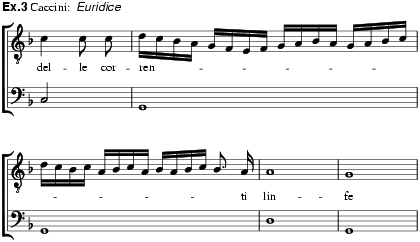
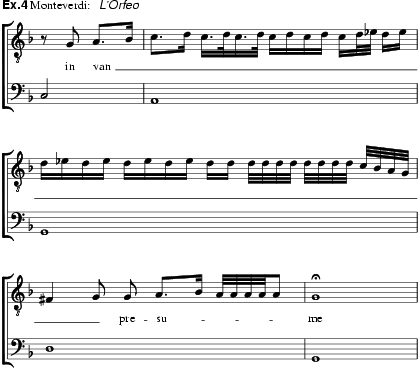
As early as 1585 Giovanni Bassano’s treatise Ricercate, passaggi et cadentie per potersi essercitar nel diminuir discussed how to invent cadenzas and provided examples. Cadenzas in 16th-century instrumental music, outside treatises, resembled those used in vocal music; for example, the cadenzas on penultimate notes in the lutebook of Hans Neusidler (1536) often resemble contemporary vocal endings in which melismatic embellishments were inserted between two full closes, repeating the last word or words. In vocal music diminutions or fioriture were often used to emphasize certain words, sometimes the final ones of the text; although inserted at points other than at cadences, they came to be called ‘cadenzas’.
Praetorius’s discussion (Syntagma musicum, iii, 1618) of ‘Cadentien und Passaggien’ often refers to what are now called word-painting embellishments. Another use of the term is found in the preface to Frescobaldi’s Toccate e partite d’intavolatura di cimbalo et organo … libro primo (1615); he wrote: ‘[As for] cadenzas, even though they may be written in fast notes, it is best to play them quite slowly; and in the approach to the end of [an embellished] passage or cadenza, the tempo should be slower still’. It seems that Frescobaldi understood by ‘cadenze’ accumulations of embellishments near any cadence rather than merely at ornamented endings of sections or whole pieces.
In the course of the development of opera in the late 17th and early 18th centuries the popularity of virtuoso singing increased considerably, and with it the importance of improvised embellishment. Final cadenzas became common towards the end of the century, when they were indicated by the words ‘solo’, ‘tenuto’, ‘ad arbitrio’, by a rest (sometimes as little as one beat), or by a fermata. In Alessandro Scarlatti’s early operas places for cadenzas can be found, but they are clearer in operas written after about 1715; even then not every aria allowed the insertion of a cadenza. In da capo arias the usual place for the insertion of a cadenza was just before the final cadence of the first section. Probably it was intended that a cadenza be performed only in the da capo of that section, but often a place for a cadenza is also found at the end of the middle section (and sometimes there only). P.F. Tosi, himself a virtuoso singer, condemned the excessive ornamentation in which some singers indulged. Referring specifically to the cadenza, he wrote in his Opinioni de’ cantori antichi e moderni, 1723 (Galliard’s translation, 1742):
Every Air has (at least) three Cadences, that are all three final. Generally speaking, the Study of the Singers of the present Times consists in terminating the Cadence of the first Part with an overflowing of Passages and Divisions at Pleasure, and the Orchestre waits; in that of the second the Dose is encreased, and the Orchestre grows tired; but on the last Cadence, the Throat is set a going, like a Weather-cock in a Whirlwind, and the Orchestre yawns.
No doubt Tosi’s opinions would have sounded old-fashioned in 1723, and regrettably he gave no guidance in the execution of what he considered an acceptable cadenza. A few samples of actual cadenzas have survived as insertions in manuscript scores. The cadenzas sung by Farinelli in ‘Quell’usignolo’ from Giacomelli’s Merope (1734; see Brown, 1984) would surely have met with Tosi’s disapproval. More to his taste, possibly, would have been the cadenzas added to a manuscript score of Handel’s opera Poro (1731). They appear at the final cadence of the first section of Alessandro’s aria ‘Vil trofeo d’un alma imbelle’, and are written on blank instrumental staves above the voice part; presumably the first was sung at the first statement, and the second at the da capo (ex.5). Cadences at which such embellishment was expected are often marked ‘adagio’; reduced scoring at this point not only highlights the display of vocal virtuosity but also helps to avoid problems of ensemble.
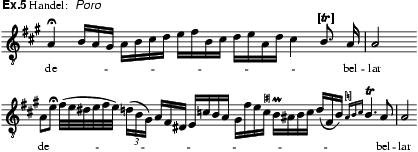
The terminological confusion surrounding cadenza-like passages in instrumental music of the late Baroque is caused in part by a lack of consistency in the sources themselves, in part by a 20th-century desire to identify the antecedents of the classical concerto cadenza, and in part by a tendency to use the term ‘cadenza’ loosely to describe any passage of virtuoso figuration that occurs in the vicinity of a cadence.
Torelli used the term Perfidia to describe three passages (nos.65–7 in Giegling’s catalogue) in which two violins engage in brilliant figurations above a sustained pedal in the bass. (The authenticity of the first has been questioned, and the second and third are part of the same composition.) The term has been used to describe similar passages in the music of Corelli and Vivaldi, such as the conclusion of the second movement of Corelli’s Sonata op.5 no.3 (ex.6).
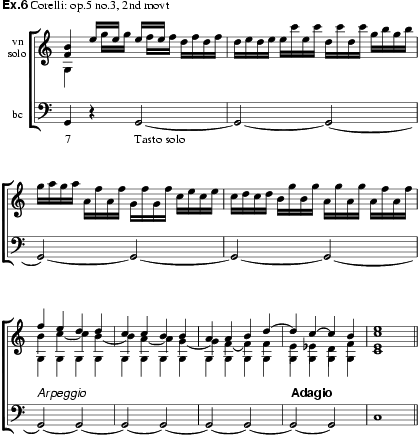
Locatelli applied the term Capriccio to the virtuoso passages for solo violin that conclude the outer movements of each of his 12 concertos op.3. (In 18 of the 24 capriccios he used the word ‘cadenza’ to indicate an improvised embellishment of the final cadence in the capriccio.) Similar passages are found in the concertos of Vivaldi, who often preceded them with the instruction ‘Qui si ferma a piacimento’, thus confirming their optional status (see illustration from rv212a). J.S. Bach made his transcription for organ bwv594 not from the printed version of Vivaldi’s op.7/ii no.5 (rv208a) but from the version found in D-SWl Mus.ms.5565 (rv208), whose first and last movements each contain additional cadenza-like passages that are not present in the printed edition. The passage in the last movement is clearly of the capriccio type: a ‘final’ ritornello in the tonic is followed by a virtuoso solo section of 104 bars, which is rounded off by a seven-bar tutti. Bach’s most famous ‘cadenza’, in the first movement of the fifth Brandenburg Concerto, should probably be seen as part of this capriccio tradition, rather than as an antecedent of the classical cadenza.
The ‘true’ cadenza was characterized not only by its placing (within a structural cadence), but also by its clear articulation (often by means of a fermata), and by its rhapsodic, improvisatory character. (The common rule, often cited with reference to cadenzas for voices or wind instruments, that the length of a cadenza should not exceed what can be sung or played in one breath, cannot have been applied rigidly.) In Bach’s concertos, cadenzas of this kind appear in the Violin Concerto in E (bwv1042; first movement), and in the Concerto for Flute, Violin and Harpsichord (bwv1044; finale).
In French music of the 16th and 17th centuries the practice of diminution developed mainly in the couplets of the air de cour, by such composers as Antoine Boësset and Etienne Moulinié, and in lute music; but no special accumulation of embellishments towards the end of a piece can be observed. Mersenne (Harmonie universelle, 1636–7) described the vocal counterparts to instrumental ‘tremblements’ (trills) as ‘cadences’, and the terms ‘tremblement’ and ‘cadence’ became interchangeable. French methods of vocal embellishment seem to have been little influenced by Italian ones. After Lully the realization of melodic ornaments and their written indication by French composers apparently permitted neither the alteration of pitches nor that accumulation of embellishments towards the end of a section from which the typical fermata embellishment of the Italian high Baroque aria evolved.
French theorists continued to be vexed by the double meaning of the word ‘cadence’, which was used for harmonic closes as well as for trills on the penultimate note. Brossard (Dictionaire de musique, 1703), for example, argued against the latter: ‘Cadence, in Latin clausula, means to close a melody and its harmony in a proper way [i.e. cadence]. This is what we should call cadence, and not what we French do who call a trill cadence’. The misuse of the term ‘cadence’ was also noted by M.P. de Montéclair (Principes de musique, 1736), who spoke of the ‘tremblement … que les Français appellent par corruption cadence’. Later, Quantz could observe in Paris that in pieces in the French style, by contrast with those in the Italian, ‘hardly anything can be added to what the composer has written’. The insertion of cadenzas in French 18th-century music was evidently restricted to works in the Italian manner.
The art of improvised embellishments flourished in Italian and Italian-influenced music in the second half of the 18th century even more than in the first half. The cadenza was considered an embellishment, and the ability to invent one was reckoned an indispensable part of the equipment of any virtuoso who hoped to satisfy the listener’s expectations. Under normal circumstances no soloist could afford to leave out a cadenza when a fermata appeared in a recognized context.
Cadenzas in the 18th century occupy the penultimate position in the musical structure. They precede the final tutti of a concerto movement or aria, and are almost always indicated by a fermata above the 6-4 chord over the dominant scale degree immediately preceding a perfect cadence. Some concertos specify a cadenza in each movement, though the trend in the later 18th century was towards one or at most two per work. Mozart’s Clarinet Concerto, exceptionally, calls for no such elaboration of a 6-4 chord.
Cadenzas
are sometimes indicated in movements of solo or chamber works. Nine of Haydn’s
string quartets require the first violinist to improvise a cadenza for the slow
movements (more than half of these occur in the set op.9, composed in 1768–9),
and cadenzas are also required in the slow movement of three of his earlier
keyboard sonatas. Mozart asked for a cadenza in the slow movement of his Duo in
B![]() for violin and viola
(k424), but more often he wrote them into his solo and
chamber music: there is a ‘cadenza’ written into the finale of the Violin
Sonata in D k306 (1778), and a ‘cadenza in tempo’ for the
finales of the Piano Sonata in B
for violin and viola
(k424), but more often he wrote them into his solo and
chamber music: there is a ‘cadenza’ written into the finale of the Violin
Sonata in D k306 (1778), and a ‘cadenza in tempo’ for the
finales of the Piano Sonata in B![]() k333 (1783) and the Piano
Quintet k452 (1784). Related to the ‘cadenza in tempo’
and also dating from the early 1780s is the written-out elaboration of the 6-4
chord not specifically identified by the composer as a ‘cadenza’ but
nevertheless fulfilling its function: examples are found in the slow movements
of Haydn’s Keyboard Sonata hXVI:39 (1780) and Quartet
op.33 no.5 (1781), and the first movement of Mozart’s Quintet in C k515 (1787). Originally, the first number of Die Zauberflöte
was to have ended with a cadenza for the Three Ladies.
k333 (1783) and the Piano
Quintet k452 (1784). Related to the ‘cadenza in tempo’
and also dating from the early 1780s is the written-out elaboration of the 6-4
chord not specifically identified by the composer as a ‘cadenza’ but
nevertheless fulfilling its function: examples are found in the slow movements
of Haydn’s Keyboard Sonata hXVI:39 (1780) and Quartet
op.33 no.5 (1781), and the first movement of Mozart’s Quintet in C k515 (1787). Originally, the first number of Die Zauberflöte
was to have ended with a cadenza for the Three Ladies.
An improvised embellishment of a different order consists of a brief elaboration, usually of a dominant chord, to connect the end of one section with the beginning of the next; the sign for it is a fermata over that chord. J.A. Hiller called this an ‘Übergang’ in his Anweisung zur Singekunst in der deutschen und italienischen Sprache (1773), but the word Eingang (‘introduction’ or ‘lead-in’), used by Mozart in a letter of 15 February 1783, has become the standard term. Where composers wrote out a series of Eingängein the course of the movement, rather than leave their execution to the soloist, they would vary them, usually by making them increasingly elaborate (see, for instance, the finales of Beethoven’s third and fourth piano concertos). Eingänge are commonly found before the reprise of the main theme in rondo movements in concertos, but can also occur in chamber and solo contexts, for example in the slow movements of Haydn’s quartets op.17 no.3 and op.20 no.6 (both marked by a fermata), and the finale of Mozart’s Sonata in D k311 (fully written out).
The rules for the construction of cadenzas given in Tartini’s Traité des agréments (1771) seem to have been widely followed and resemble in principle those given for singers: cadenzas may start with a swelling note (for singers, a messa di voce), passaggi or a trill, succeeded by metrically free notes of smaller value and then a high note that may be identical with or followed by the highest note in the piece; the melodic peak is usually soon followed by the soloist’s final trill. This basic form stood throughout the 18th century in Italy, and for much of it elsewhere; but the freedom given to performers, when abused, sometimes led to monstrosities.
P.F. Tosi was one of the more outspoken opponents of the presumption of singers. His Opinioni de’ cantori antichi e moderni (1723; see §2) allows for the insertion of at most one cadenza into an aria, and then only towards the end of the da capo section, so that the audience would know when the aria was coming to an end; otherwise only modest embellishments might be included. A cadenza should, moreover, not break the metre. J.F. Agricola’s Anleitung zur Singekunst (1757), an edited German translation of Tosi’s Opinioni, expressed a different opinion in a footnote, commenting that this excessively narrow restriction was usually ignored, but he agreed that many a singer spoilt an otherwise well-performed aria by the inclusion of excessively long or absurdly designed cadenzas. From the numerous complaints registered by 18th-century writers, one may infer that not only singers but also instrumentalists often extended their final cadenzas to excessive lengths; Tosi’s near-contemporary Benedetto Marcello (in Il teatro alla moda, 1720) mocked the ‘cadenze lunghissime’ of the ‘virtuoso di violino primo’.
Cadenzas were also discussed in detail by German theorists and singing masters working in German-speaking countries. Quantz described them at length in his Versuch einer Anweisung die Flöte traversière zu spielen (1752, chap.15, ‘Hauptstück’), while C.P.E. Bach’s Versuch über die wahre Art das Clavier zu spielen (1753) discussed them under the rubrics ‘Aufgehaltene Schlusscadenzen’ and ‘Fermaten-Auszierungen’. (75 of Bach’s cadenzas survive in a single fascicle identified as item 264 in Helm’s thematic catalogue; three-quarters of these are for his own keyboard concertos.) Both Quantz and Bach were more cautious in their recommendations than Hiller, who seems to have been the only well-known German theorist to abandon the principle that a singer’s cadenza should be capable of being executed in a single breath. G.B. Mancini, a singing teacher at the imperial court in Vienna and one of the most important authorities on the Italian singing tradition, recognized that the one-breath rule was often broken, as he demanded in his Pensieri, e riflessioni pratiche sopra il canto figurato (1774) that a singer have the ‘correct judgment’ to ‘escape the embarrassment occasioned by shortness of breath … for he might find himself … unable to perfect the cadenza with a trill’.
Mancini touched on another important question concerning cadenzas, namely the relationship of improvised passages to the thematic material. ‘This same judgment’, he wrote, ‘should lead the singer to choose a motif from the cantilena of the … aria.’ On this matter there was no uniformity of opinion during the 18th century. Quantz suggested that a singer who could not think of something new with which to begin a cadenza should choose instead one of the most attractive motifs from the aria and build a cadenza from it. If the record of the century’s greatest composers is anything to go by, J.S. Bach, his sons, Haydn and Mozart all composed non-thematic cadenzas (exx.7 and 8 show alternative non-thematic vocal cadenzas by Haydn and Mozart), and only from about 1779 onwards do Mozart’s cadenzas begin to quote or develop thematic material from the concerto to which they belong.
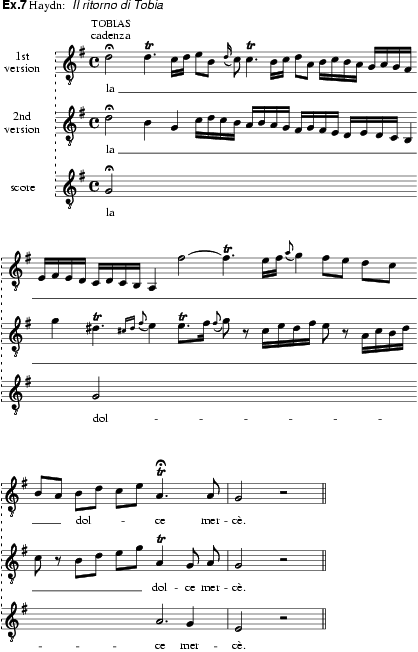
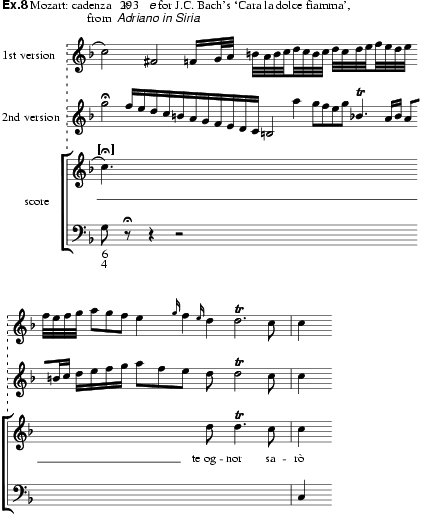
The
most comprehensive theory of the cadenza in the 18th century is found in D.G.
Türk’s Clavierschule (1789). Türk also lamented the practice of making
inordinately lengthy cadences that often had little to do with the piece they
were meant to embellish, with the result that the piece became ‘cadenza-ed
away’ (wegkadenziert). To remedy this he drew up a list of ten rules
governing cadenzas, which may be summarized as follows: 1. The
cadenza should reinforce the impression made by the composition by providing a
brief summary of it; this may be achieved by weaving some of the important
ideas from the piece into the cadenza.
2. The cadenza should not be difficult for its own sake, but
rather contain thoughts that are suited to the main character of the
composition.
3. The cadenza should not be too long, especially in sad
compositions.
4. Modulations should be avoided or used only in passing, and
should never stray beyond the main keys established in the piece.
5. The cadenza, in addition to expressing a unified sentiment,
must have some musical variety to maintain the listener’s interest.
6. Ideas should not be repeated, either in the same key or in
different keys.
7. Dissonances, even in single-voiced cadenzas, must be
properly resolved.
8. A cadenza need not be learnt, but should show ‘novelty, wit
and an abundance of ideas’.
9. In a cadenza the performer should not stay in one tempo or
metre too long, but should give the impression of ‘ordered disorder’. A cadenza
may be usefully compared to a dream, in which events that have been compressed
into the space of a few minutes make an impression, yet lack coherence and
clear consciousness.
10. A cadenza should be performed as though it had just
occurred to the performer. Nevertheless, it is risky to improvise a cadenza on
the spot, and much safer to write it down or at least sketch it in advance.
The absence of ‘authentic’ cadenzas to six of Mozart’s most frequently performed concertos is probably the main reason for our historical and theoretical concern with the cadenza. Türk’s rules concur remarkably well with Mozart’s surviving cadenzas, but they are not sufficiently detailed to lead the performer in the direction of a ‘Mozartian’ cadenza. The best models for the missing cadenzas are, of course, Mozart’s surviving cadenzas, and these have been analysed in a number of ways: thematically, formally and in terms of part-writing structure. Recent scholarship suggests that the Schenkerian concept of ‘composing out’ by various techniques of ‘prolongation’ is a useful modelling tool (Swain, 1988; Drabkin, 1996); the notion of cadenza as prolongation, already part of its definition, gains in credibility when one considers that Mozart often expanded an early cadenza when reviving the work in concert (see especially the surviving cadenzas to the first two movements of k271).
In defiance of the spirit of the 18th-century concerto, performers today almost always play Mozart’s cadenzas (if these survive), rather than invent their own at the end of a concerto movement; where more than one cadenza exists for a particular movement, they prefer the later (or latest) one. In these respects they are generally supported by musicologists, who hold Mozart’s cadenzas to be canonical; as a result, the cadenza is already familiar to the audience before they hear a single note of it, rendering Türk’s rule no.10 irrelevant. Given the demise of the composer-performer in the 20th century, this situation is likely to prevail for some time.
Beethoven’s
concerto cadenzas comprise two classes: early essays, from about 1795 to 1800,
for which only sketches or rudimentary drafts exist, and a canonical set of
some dozen cadenzas written out around 1809 for his pupil Archduke Rudolph. The
sketch papers include a cadenza for an unknown keyboard work in G major, and
substantial drafts of three cadenzas for the B![]() piano concerto (no.2) and two for the C major (no.1).
These early examples show that Beethoven, like Mozart, liked to quote an
important idea – usually the principal second-group theme – in the middle of
the cadenza; unlike Mozart, though, he set this theme on a scale-step that was
harmonically remote from the tonic, such as the flattened 3rd, 6th or 7th. Of
the canonical set, that for the Piano Concerto no.2 and two of those for no.1
far exceed Mozart’s stylistic, registral, temporal and technical limits, but
even the early cadenzas already show Beethoven as a patron of the ‘cadenze
lunghissime’ school. The cadenza for the Piano Concerto no.3 is stylistically
more compatible with its concerto, in many respects a transitional work.
Sketches from late 1808 suggest that the longest, and currently most often
played, of the cadenzas for the Fourth Piano Concerto is similar to what
Beethoven improvised at its first public performance on 22 December 1808.
piano concerto (no.2) and two for the C major (no.1).
These early examples show that Beethoven, like Mozart, liked to quote an
important idea – usually the principal second-group theme – in the middle of
the cadenza; unlike Mozart, though, he set this theme on a scale-step that was
harmonically remote from the tonic, such as the flattened 3rd, 6th or 7th. Of
the canonical set, that for the Piano Concerto no.2 and two of those for no.1
far exceed Mozart’s stylistic, registral, temporal and technical limits, but
even the early cadenzas already show Beethoven as a patron of the ‘cadenze
lunghissime’ school. The cadenza for the Piano Concerto no.3 is stylistically
more compatible with its concerto, in many respects a transitional work.
Sketches from late 1808 suggest that the longest, and currently most often
played, of the cadenzas for the Fourth Piano Concerto is similar to what
Beethoven improvised at its first public performance on 22 December 1808.
Beethoven also wrote out a cadenza for the first movement of the Violin Concerto as arranged for piano and orchestra; this cadenza, which contains a substantial part for the timpani, is thus contemporary with the Fifth Piano Concerto, whose finale similarly contains a duet for piano and timpani towards the end. Perhaps the most successful of all his cadenza enterprises, viewed from a Beethovenian perspective, are the pair (woo58) written for Mozart’s D minor Piano Concerto k466. The first-movement cadenza contains rapid shifts in register, quotes the main second-group theme in a remote key and the pianist’s opening cantabile in the home key, and generally sums up the mood of Mozart’s work in what, for Beethoven, is a modest space of 61 bars. The paradox of Beethoven’s mastery of the spirit of the cadenza via a concerto from an earlier age is symptomatic of the central problem of the genre: in being written down – or, indeed, in any other way recorded – it ‘intrudes into the workings of the concerto, attributing to itself a textual presence that the conventions of the genre seem to disallow’ (Kramer, 1991–2).
It
is sometimes suggested that Beethoven’s rapid writing down of his collected
cadenzas was motivated by his reluctance to allow others to supply their own
cadenzas for his concertos. (When Ferdinand Ries performed the Third Piano
Concerto in 1804, the composer at first insisted that his pupil compose his own
cadenza, but later expressed his unease about one passage and attempted to make
Ries change it.) Or he may have recognized the increasing incompatibility of
composition and improvisation in the middle period: the Fifth Piano Concerto, a
work contemporary with the canonical cadenzas and the last he was to complete,
bears the famous remark at the relevant 6-4 chord in the first movement: ‘Non
si fa una cadenza, ma s’attacca subito il seguente’. What follows in the score,
ironically, reverts to the 18th-century cadenza aesthetic: it is of modest
length, uses a combination of fixed and free rhythms, and remains throughout in
the home key of E![]() (the
mixture of major and minor is a typical feature of Mozart’s cadenzas). Only the
role of the orchestra has changed: it now participates in the elaboration of
the 6-4 chord.
(the
mixture of major and minor is a typical feature of Mozart’s cadenzas). Only the
role of the orchestra has changed: it now participates in the elaboration of
the 6-4 chord.
Beethoven also wrote cadenzas into a few solo and chamber works. The first movement of his brilliant Piano Sonata in C op.2 no.3 contains a short working out in free rhythm of the main motif. The first movement of the Cello Sonata in F op.5 no.1 includes a more complex example of almost 40 bars. Of special interest is the harmonic progression to and from the central Adagio (ex.9), in which modal mixture (bars 359–61) and the prolongation of IV with flattened 7th (bars 362–7) combine to give the illusion of a modulation to a remote key. Being complete and fully written out, the cadenza in op.5 no.1 is one of the best models we have from Beethoven’s early period.
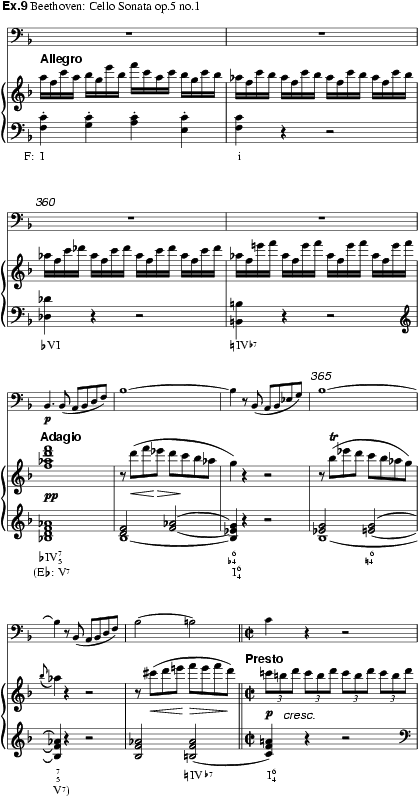
Following Beethoven’s lead in the Fifth Piano Concerto, 19th-century pianist-composers usually wrote their own cadenzas into the score, or they dispensed with them altogether. Significantly, Liszt rarely left a fermata sign indicating that the performer should insert a cadenza; he supplied all such material himself. Even in his transcriptions of operatic arias by Rossini, Bellini and others, Liszt wrote out cadenzas at those points where, in the original works, fermatas indicate their insertion. But the tradition of writing cadenzas to earlier concertos was maintained by piano virtuosos: for Beethoven’s Fourth Piano Concerto, for instance, there are substantial cadenzas by Clara Schumann, Brahms, Moscheles, Rubinstein and Bülow. Because they violate the ‘authenticity’ principle, they are hardly ever performed now, and writers have traditionally viewed them as examples of the excesses for which 18th-century performers were censured. It is perhaps more fruitful, though, to respect them for what they are, namely, the 19th century’s artistic response to the masterpieces of an earlier age and an insight into the way virtuosos understood and appreciated the classics (Kwan, 1994).
Violinists and singers, on the other hand, consistently demanded the right to shape cadenzas according to their specific technical abilities. Operas by Italian composers of the first half of the 19th century still contained many fermata signs indicating places for improvised embellishment. In Germany and France, however, such opportunities for singers’ display became increasingly rare. In Meyerbeer’s operas places for cadenzas are found mainly in those arias written in an Italian style, rather than in those in a German or French style. In Italy it was Verdi who finally broke with tradition. Only in his earliest operas did he allow the singers to improvise their own cadenzas; his mature ones contain cadenzas he composed himself, or none at all. Other Italian opera composers were the last to curtail the performer’s traditional rights in this way, and the art of improvising cadenzas gradually died out around the turn of the century. Cadenzas in concertos or arias written after 1880 are virtually always written out: exceptions are the violin concertos of Brahms, Szymanowski and Khachaturian.
GroveO (A.V. Jones, W. Crutchfield)
M. Kuhn: Die Verzierungs-Kunst in der Gesangs-Musik des 16.–17. Jahrhunderts (1535–1650) (Leipzig, 1902/R)
A. Schering: ‘Die Freie Kadenz im Instrumentalkonzert des 18. Jahrhunderts’, IMusSCR II: Basle 1906, 204–11
H. Goldschmidt: Die Lehre von der vokalen Ornamentik (Berlin, 1907)
H. Knödt: Die Konzertkadenz (diss., U. of Vienna, 1911)
H. Knödt: ‘Zur Entwicklungsgeschichte der Kadenzen im Instrumentalkonzert’, SIMG, xv (1913–14), 375–419
M. Pincherle: ‘Sur une cadence-caprice pour violon de l’an 1695’, RdM, iii (1922), 164–7
F. Haböck: Die Gesangkunst der Kastraten (Vienna, 1923)
H. Engel: Die Entwicklung des deutschen Klavierkonzertes von Mozart bis Liszt (Leipzig, 1927/R)
R. Haas: Aufführungspraxis der Musik (Potsdam, 1931)
H.J. Moser: ‘Das Schicksal der Penultima’, JbMP 1934, 25–31
R. Stockhammer: Die Kadenzen zu den Klavierkonzerten der Wiener Klassiker (diss., U. of Vienna,1936)
E.T. Ferand: Die Improvisation in der Musik (Zürich, 1938)
D.F. Tovey: ‘Prefaces to Cadenzas for Classical Concertos’, Essays and Lectures on Music (London, 1949), 315–29
A. Schmitz: ‘Die Kadenz als Ornamentum musicae’, GfMKB: Bamberg 1953, 114–20
W. Kolneder: Aufführungspraxis bei Vivaldi (Leipzig, 1955)
H.-P. Schmitz: Die Kunst der Verzierung im 18. Jahrhundert (Kassel, 1955, 4/1983)
E. and P. Badura-Skoda : Mozart-Interpretation (Vienna, 1957; Eng. trans., 1962/R, as Interpreting Mozart on the Keyboard)
E.T. Ferand: Die Improvisation in Beispielen aus neun Jahrhunderten abendländischer Musik, Mw, xii (1956, 2/1961; Eng. trans., 1961)
G. Katzenberger: Die Kadenz im Instrumentalkonzert bei Beethoven und das Stilproblem der nichtoriginalen Kadenzen zu Beethovens Konzerten (diss., U. of Innsbruck, 1963)
P. Ryom: ‘La comparaison entre les versions différentes d’un concerto d’Antonio Vivaldi transcrit par J.S. Bach’, DAM, v (1966–7), 91–111
E. Badura-Skoda: ‘Clementi’s “Musical Characteristics” Opus 19’, Studies in Eighteenth-Century Music: a Tribute to Karl Geiringer, ed. H.C.R. Landon and R.E. Chapman (New York and London, 1970), 53–67
P. Mies: Die Krise der Konzertkadenz bei Beethoven (Bonn, 1970)
P. Mies: Das Konzert im 19. Jahrhundert: Studien zu Formen und Kadenzen (Bonn, 1972)
C. Warren: ‘Punctus organi and cantus coronatus in the Music of Dufay’, Dufay Conference: Brooklyn, NY, 1974, 128–43
O. Edwards: ‘The Cadenza in Eighteenth-Century English Concerto Fugues’, MR, xxxvi (1975), 92–101
G.J. Buelow: ‘A Lesson in Operatic Performance Practice by Madame Faustina Bordoni’, A Musical Offering: Essays in Honor of Martin Bernstein, ed. E.H. Clinkscale and C. Brook (New York, 1977), 79–96
D. Lasocki and B.B. Mather: The Classical Woodwind Cadenza: a Workbook (New York, 1978)
C. Wolff: ‘Zur Chronologie der Klavierkonzertkadenzen Mozarts’, MJb 1978–9, 235–46
H.M. Brown: ‘Embellishing Eighteenth-Century Arias: on Cadenzas’, Opera & Vivaldi: Dallas 1980, 258–76
R.W. Wade: The Keyboard Concertos of Carl Philipp Emanuel Bach: Sources and Style (Ann Arbor, 1981)
J.A. Mueter: ‘An Unpublished Cadenza by Gounod for Mozart’s Piano Concerto K491’, CMc, no.34 (1982), 26–41
U. Johansen: The Instrumental Cadenza of the Period c.1700–c.1770: a Study of the Cadenza of the Periods Preceding the ‘Classical’ Era, based on Eighteenth-Century Writings and Surviving Musical Material (Uppsala, 1983)
E.T. Cone: ‘A Cadenza for Op.15’, Beethoven Essays: Studies in Honor of Elliot Forbes, ed. L. Lockwood and P. Benjamin (Cambridge, MA, 1984), 99–107
F. Neumann: Ornamentation and Improvisation in Mozart (Princeton, NJ, 1986)
J.P. Swain: ‘Form and Function of the Classical Cadenza’, JM, vi (1988), 27–59
P. Whitmore: ‘Towards an Understanding of the Capriccio’, JRMA, cxiii (1988), 47–56
H.M. Brown and S. Sadie, eds.: Performance Practice: Music after 1600 (London, 1989) [incl. R.D. Levin: ‘Instrumental Ornamentation, Improvisation and Cadenzas’, 267–91; W. Crutchfield: ‘Voices’, 292–319, 424–58]
P. Whitmore: Unpremeditated Art: the Cadenza in the Classical Keyboard Concerto (Oxford, 1991)
R. Kramer: ‘Cadenza contra Text: Mozart in Beethoven’s Hands’, 19CM, xv (1991–2), 116–31
K. Kwan: Cadenza as Reception: Stylistic and Structural Analysis of Selected Cadenzas for the First Movement of Beethoven’s Piano Concerto Op.58 (diss., U. of Hong Kong, 1994)
W. Drabkin: ‘An Interpretation of Musical Dreams: Towards a Theory of the Mozart Piano Concerto Cadenza’, Wolfgang Amadè Mozart: Essays on his Life and his Music, ed. S. Sadie (Oxford, 1996), 160–77
For further bibliography see Improvisation, §IV.